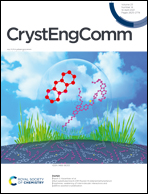Molecular motion of halogenated ethylammonium/[18]crown-6 supramolecular ions in nickel dithiolate magnetic crystals†
Abstract
Supramolecular cations, consisting of ethylammonium derivatives (X–CH2CH2–NH3+) complexed with [18]crown-6, were incorporated into [Ni(dmit)2]− crystals in order to promote molecular motion. Crystals of (X–CH2CH2–NH3+)([18]crown-6)[Ni(dmit)2]− (1: X = H, 2: X = F, 3: X = Cl and 4: X = Br) were prepared for this purpose. Although large amplitude molecular motions do not occur in crystal 1, dynamic disorder of F–CH2 groups takes place between two sites in crystal 2. Similar disorder of Cl–CH2 groups along with rotation of [18]crown-6 molecules also exists in crystal 3. Crystal 4 exhibits dynamic disorder of Br–CH2–CH2 groups between four sites. This is especially the case for crystal 4 which undergoes a distinct dielectric response with relaxer-like behavior in the temperature dependence of the dielectric loss tangent. Interactions between [Ni(dmit)2]− ions in all crystals are antiferromagnetic, and the magnitudes of the interactions are qualitatively consistent with the strength of intermolecular interactions estimated from transfer integrals, where interactions within [Ni(dmit)2]− dimers are the larger than the others in all crystals.
![Graphical abstract: Molecular motion of halogenated ethylammonium/[18]crown-6 supramolecular ions in nickel dithiolate magnetic crystals](/en/Image/Get?imageInfo.ImageType=GA&imageInfo.ImageIdentifier.ManuscriptID=D1CE00253H&imageInfo.ImageIdentifier.Year=2021)
- This article is part of the themed collection: Supramolecular & Polymorphism


 Please wait while we load your content...
Please wait while we load your content...